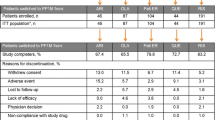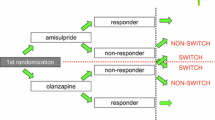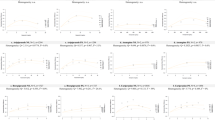Abstract
Rationale
Evidence on sequential trial with atypical antipsychotics has been scarce.
Objectives
We conducted an algorithm-based antipsychotic pharmacotherapy.
Materials and methods
In this open-label study, patients with schizophrenia (DSM-IV) were treated with antipsychotic monotherapy, step-by-step, with each trial lasting up to 8 weeks. At baseline, they were highly symptomatic to score more than 54 in the total Brief Psychiatric Rating Scale (BPRS1–7) score. When the posttreatment BPRS score was above 70% of the baseline, they were subsequently treated with another and up to three atypicals. Basically, anticholinergics were prohibited, and only adjunctive allowed was lorazepam. The secondary endpoint was a clinical status good enough to be discharged for 66 inpatients and a successful continuation therapy with the same antipsychotic agent for more than 6 months for 12 outpatients.
Results
Three groups of 26 patients each were randomized to Olanzapine, Quetiapine, or Risperidone. Thirty-nine (50%) responded to the first agent (Olanzapine16, Quetiapine9, Risperidone14), and 14 responded to the second. Only two showed response to the third, and 16 failed to respond to all three antipsychotics, with only 7 dropouts. Overall, there were 22 Olanzapine, 14 Quetiapine, and 19 Risperidone responders. Based on the secondary outcome, 20 Olanzapine-treated (average maximum dose, 15.4 mg), 10 Quetiapine-treated (418 mg), and 20 Risperidone-treated (4.10 mg) patients responded. The difference in response as the first choice was significant (p < 0.05). Relative doses of those failing to respond were comparable (Olanzapine 18.3 mg, Quetiapine 564 mg, Risperidone5.47 mg). Extrapyramidal symptoms did not change significantly.
Conclusions
When the first atypical antipsychotic is inadequate, switching to the second is worth trying, although some remain treatment-refractory. Quetiapine may be inferior to Olanzapine and Risperidone in symptomatic patients.



Similar content being viewed by others
References
Alvarez E, Ciudad A, Olivares JM, Bousono M, Gomez JC (2006) A randomized, 1-year follow-up study of olanzapine and risperidone in the treatment of negative symptoms in outpatients with schizophrenia. J Clin Psychopharmacol 26:238–249
American Psychiatric Association (1994) Diagnostic and statistical manual of mental disorders, 4th edn. American Psychiatric Press, Washington, DC
Andreasen NC, Carpenter WT Jr, Kane JM, Lasser RA, Marder SR, Weinberger DR (2005) Remission in schizophrenia: proposed criteria and rationale for consensus. Am J Psychiatr 162:441–449
Ciompi L (1980) The natural history of schizophrenia in the long term. Br J Psychiatry 136:413–420
Citrome L, Jaffe A, Levine J, Lindenmayer JP (2005) Dosing of quetiapine in schizophrenia: how clinical practice differs from registration studies. J Clin Psychiatry 66:1512–1516
Cooper D, Moisan J, Gaudet M, Abdous B, Gregoire JP (2005) Ambulatory use of olanzapine and risperidone: a population-based study on persistence and the use of concomitant therapy in the treatment of schizophrenia. Can J Psychiatry 50:901–908
Davidson L, McGlashan TH (1997) The varied outcomes of schizophrenia. Can J Psychiatry 42:34–43
Davis JM, Chen N, Glick ID (2003) A meta-analysis of the efficacy of second-generation antipsychotics. Arch Gen Psychiatry 60:553–564
Dossenbach M, Arango-Davila C, Silva Ibarra H, Landa E, Aguilar J, Caro O, Leadbetter J, Assuncao S (2005) Response and relapse in patients with schizophrenia treated with olanzapine, risperidone, quetiapine, or haloperidol: 12-month follow-up of the Intercontinental Schizophrenia Outpatient Health Outcomes (IC-SOHO) study. J Clin Psychiatry 66:1021–1030
Expert consensus guideline series (2003) Optimizing pharmacologic treatment of psychotic disorders. J Clin Psychiatry 64(Suppl 12):2–97
Gastpar M, Masiak M, Latif MA, Frazzingaro S, Medori R, Lombertie ER (2005) Sustained improvement of clinical outcome with risperidone long-acting injectable in psychotic patients previously treated with olanzapine. J Psychopharmacol 19(5 Suppl):32–38
Geddes J, Freemantle N, Harrison P, Bebbington P (2000) Atypical antipsychotics in the treatment of schizophrenia: systematic overview and meta-regression analysis. Br Med J 321(7273):1371–1376
Gianfrancesco F, Rajagopalan K, Wang RH (2006a) Hospitalization risks in the treatment of schizophrenia: comparison of antipsychotic medications. J Clin Psychopharmacol 26:401–404
Gianfrancesco FD, Rajagopalan K, Sajatovic M, Wang RH (2006b) Treatment adherence among patients with schizophrenia treated with atypical and typical antipsychotics. Psychiatry Res 144:177–189
Guy W (1976) ECDEU assessment manual for psychopharmacology. Department of Health, Education and Welfare, Washington DC, pp 217–222
Haro JM, Novick D, Suarez D, Alonso J, Lepine JP, Ratcliffe M; SOHO Study Group (2006) Remission and relapse in the outpatient care of schizophrenia: three-year results from the Schizophrenia Outpatient Health Outcomes study. J Clin Psychopharmacol 26:571–578
Inada T, Yagi G, Miura S (2002) Extrapyramidal symptom profiles in Japanese patients with schizophrenia treated with olanzapine or haloperidol. Schizophr Res 57:227–238
Jung DU, Conley RR, Kelly DL, Kim DW, Yoon SH, Jang JH, Shin JG, Shim JC (2006) Prevalence of bone mineral density loss in Korean patients with schizophrenia: a cross-sectional study. J Clin Psychiatry 67:1391–1396
Kane J, Honigfeld G, Singer J, Meltzer H (1988) Clozapine for the treatment-resistant schizophrenic. A double-blind comparison with chlorpromazine. Arch Gen Psychiatry 45:789–796
Kinon BJ, Noordsy DL, Liu-Seifert H, Gulliver AH, Ascher-Svanum H, Kollack-Walker S (2006) Randomized, double-blind 6-month comparison of olanzapine and quetiapine in patients with schizophrenia or schizoaffective disorder with prominent negative symptoms and poor functioning. J Clin Psychopharmacol 26:453–461
Kraus JE, Sheitman BB, Cook A, Reviere R, Lieberman JA (2005) Olanzapine versus risperidone in newly admitted acutely ill psychotic patients. J Clin Psychiatry 66:1564–1568
Lee C, Wu KH, Habil H, Dyachkova Y, Lee P (2006) Treatment with olanzapine, risperidone or typical antipsychotic drugs in Asian patients with schizophrenia. Aust N Z J Psychiatry 40:437–445
Lehman AF, Kreyenbuhl J, Buchanan RW, Dickerson FB, Dixon LB, Goldberg R, Green-Paden LD, Tenhula WN, Boerescu D, Tek C, Sandson N, Steinwachs DM (2004) The Schizophrenia Patient Outcomes Research Team (PORT): updated treatment recommendations 2003. Schizophr Bull 30:193–217
Leucht S, Davis JM, Engel RR, Kane JM, Wagenpfeil S (2007) Defining ‘Response’ in antipsychotic drug trials: recommendations for the use of scale-derived cutoffs. Neuropsychopharmacology, DOI 10.1038/sj.npp.1301325
Lieberman JA, Stroup TS, McEvoy JP, Swartz MS, Rosenheck RA, Perkins DO, Keefe RS, Davis SM, Davis CE, Lebowitz BD, Severe J, Hsiao JK; Clinical Antipsychotic Trials of Intervention Effectiveness (CATIE) Investigators (2005) Effectiveness of antipsychotic drugs in patients with chronic schizophrenia. N Engl J Med 353:1209–1223
McCue RE, Waheed R, Urcuyo L, Orendain G, Joseph MD, Charles R, Hasan SM (2006) Comparative effectiveness of second-generation antipsychotics and haloperidol in acute schizophrenia. Br J Psychiatry 189:433–440
McEvoy JP, Lieberman JA, Stroup TS, Davis SM, Meltzer HY, Rosenheck RA, Swartz MS, Perkins DO, Keefe RS, Davis CE, Severe J, Hsiao JK; CATIE Investigators (2006) Effectiveness of clozapine versus olanzapine, quetiapine, and risperidone in patients with chronic schizophrenia who did not respond to prior atypical antipsychotic treatment. Am J Psychiatr 163:600–610
Meyer JM, Pandina G, Bossie CA, Turkoz I, Greenspan A (2005) Effects of switching from olanzapine to risperidone on the prevalence of the metabolic syndrome in overweight or obese patients with schizophrenia or schizoaffective disorder: analysis of a multicenter, rater-blinded, open-label study. Clin Ther 27:1930–1941
Miller AL, Hall CS, Buchanan RW, Buckley PF, Chiles JA, Conley RR, Crismon ML, Ereshefsky L, Essock SM, Finnerty M, Marder SR, Miller DD, McEvoy JP, Rush AJ, Saeed SA, Schooler NR, Shon SP, Stroup S, Tarin-Godoy B (2004a) The Texas Medication Algorithm Project antipsychotic algorithm for schizophrenia: 2003 update. J Clin Psychiatry 65:500–508
Miller AL, Crismon ML, Rush AJ, Chiles J, Kashner TM, Toprac M, Carmody T, Biggs M, Shores-Wilson K, Chiles J, Witte B, Bow-Thomas C, Velligan DI, Trivedi M, Suppes T, Shon S (2004b) The Texas medication algorithm project: clinical results for schizophrenia. Schizophr Bull 30:627–647
Nasrallah HA, Meyer JM, Goff DC, McEvoy JP, Davis SM, Stroup TS, Lieberman JA (2006) Low rates of treatment for hypertension, dyslipidemia and diabetes in schizophrenia: data from the CATIE schizophrenia trial sample at baseline. Schizophr Res 86:15–22
Newcomer JW, Haupt DW (2006) The metabolic effects of antipsychotic medications. Can J Psychiatry 51:480–491
Novick D, Bousono M, Suarez D, Olivares JM, Montejo AL, Haro JM, Edgell ET, Ratcliffe M; SOHO Advisory Board (2005) Use of concomitant medication with antipsychotic treatment in outpatients with schizophrenia: results from the European Schizophrenia Outpatients Health Outcomes (SOHO) study. Prog Neuro-Psychopharmacol Biol Psychiatry 29:972–982
Overall JE, Gorham DR (1962) The brief psychiatric rating scale. Psychol Rep 10:799–812
Pelagotti F, Santarlasci B, Vacca F, Trippoli S, Messori A (2004) Dropout rates with olanzapine or risperidone: a multi-centre observational study. Eur J Clin Pharmacol 59:905–909
Ren XS, Qian S, Lee AF, Herz L, Miller DR, Kazis LE (2006) Treatment persistence: a comparison among patients with schizophrenia who were initiated on atypical antipsychotic agents. J Clin Pharmacol Ther 31:57–65
Rettenbacher MA, Ebenbichler C, Hofer A, Kemmler G, Baumgartner S, Edlinger M, Hummer M, Lechleitner M, Fleischhacker WW (2006) Early changes of plasma lipids during treatment with atypical antipsychotics. Int Clin Psychopharmacol 21:369–372
Sherwood M, Thornton AE, Honer WG (2006) A meta-analysis of profile and time-course of symptom change in acute schizophrenia treated with atypical antipsychotics. Int J Neuropsychopharmacol 9:357–366
Stahl SM, Grady MM (2004) A critical review of atypical antipsychotic utilization: comparing monotherapy with polypharmacy and augmentation. Curr Med Chem 11:313–327
Stroup TS, Lieberman JA, McEvoy JP, Swartz MS, Davis SM, Rosenheck RA, Perkins DO, Keefe RS, Davis CE, Severe J, Hsiao JK; CATIE Investigators (2006) Effectiveness of olanzapine, quetiapine, risperidone, and ziprasidone in patients with chronic schizophrenia following discontinuation of a previous atypical antipsychotic. Am J Psychiatr 163:611–622
Su KP, Wu PL, Pariante CM (2005) A crossover study on lipid and weight changes associated with olanzapine and risperidone. Psychopharmacology 183:383–386
Suzuki T, Uchida H, Tanaka KF, Tomita M, Tsunoda K, Nomura K, Takano H, Tanabe A, Watanabe K, Yagi G, Kashima H (2003) Reducing the dose of antipsychotic medications for those who had been treated with high-dose antipsychotic polypharmacy: an open study of dose reduction for chronic schizophrenia. Int Clin Psychopharmacol 18:323–329
Suzuki T, Uchida H, Tanaka KF, Nomura K, Takano H, Tanabe A, Watanabe K, Yagi G, Kashima H (2004a) Revising polypharmacy to a single antipsychotic regimen for patients with chronic schizophrenia. Int J Neuropsychopharmacol 7:133–142
Suzuki T, Uchida H, Watanabe K, Yagi G, Kashima H (2004b) A clinical case series of switching from antipsychotic polypharmacy to monotherapy with a second-generation agent on patients with chronic schizophrenia. Prog Neuro-Psychopharmacol Biol Psychiatry 28:361–369
Suzuki T, Uchida H, Takeuchi H, Nomura K, Tanabe A, Watanabe K, Yagi G, Kashima H (2005) Simplifying psychotropic medication regimen into a single night dosage and reducing the dose for patients with chronic schizophrenia. Psychopharmacology (Berl) 181:566–575
Wang X, Savage R, Borisov A, Rosenberg J, Woolwine B, Tucker M, May R, Feldman J, Nemeroff CB, Miller AH (2006) Efficacy of risperidone versus olanzapine in patients with schizophrenia previously on chronic conventional antipsychotic therapy: a switch study. J Psychiatr Res 40:669–676
Woodward ND, Purdon SE, Meltzer HY, Zald DH (2005) A meta-analysis of neuropsychological change to clozapine, olanzapine, quetiapine, and risperidone in schizophrenia. Int J Neuropsychopharmacol 8:457–472
Zhong KX, Sweitzer DE, Hamer RM, Lieberman JA (2006) Comparison of quetiapine and risperidone in the treatment of schizophrenia: A randomized, double-blind, flexible-dose, 8-week study. J Clin Psychiatry 67:1093–1103
Acknowledgment
This work was presented in part at the XXVth Collegium Internationale Neuro-psychopharmacologicum Congress (2006, Chicago). This study was independent from any financial support.
Conflict of interest statement
None.
Author information
Authors and Affiliations
Corresponding author
Rights and permissions
About this article
Cite this article
Suzuki, T., Uchida, H., Watanabe, K. et al. How effective is it to sequentially switch among Olanzapine, Quetiapine and Risperidone?—A randomized, open-label study of algorithm-based antipsychotic treatment to patients with symptomatic schizophrenia in the real-world clinical setting. Psychopharmacology 195, 285–295 (2007). https://doi.org/10.1007/s00213-007-0872-2
Received:
Accepted:
Published:
Issue Date:
DOI: https://doi.org/10.1007/s00213-007-0872-2




